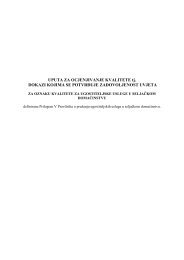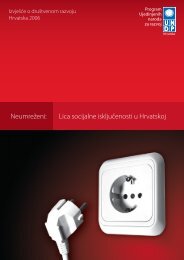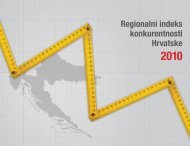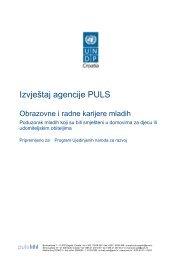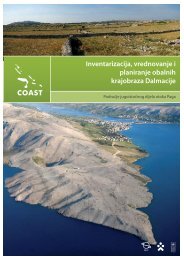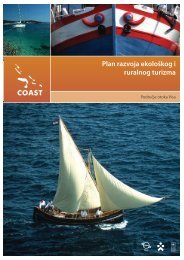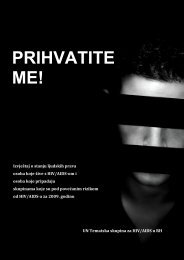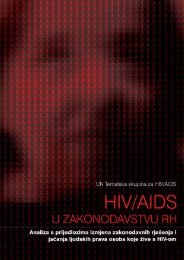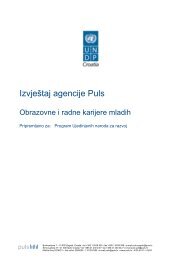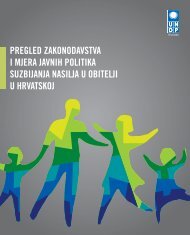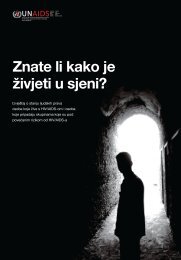WEB engleska verzija end.indd - UNDP Croatia
WEB engleska verzija end.indd - UNDP Croatia
WEB engleska verzija end.indd - UNDP Croatia
- No tags were found...
You also want an ePaper? Increase the reach of your titles
YUMPU automatically turns print PDFs into web optimized ePapers that Google loves.
CHAPTER 3THE SOCIALLY EXCLUDED124ranges from 800-1,000 persons. According to the totalnumber of treated drug users compared to the totalnumber of inhabitants, the County of Istria takes firstplace, followed by the County of Zadar, and the Countyof Šibenik-Knin. Major towns that are at the forefront ofillegal drug abuse are primarily Pula, Zadar, Trogir andSplit, followed by Zagreb, Rijeka, Vinkovci and Osijek.However, only Pula and Zadar have an unacceptablyhigh number of drug users. The most frequent mentaldisorders found in people treated for drug abuse areprimarily personality disorders, alcoholism, and depression-relateddisorders. The amount of deaths related todrug abuse, mostly due to overdose, indicates a risingtr<strong>end</strong>, ranging from only 29 in 1996 to 108 in 2004.The Life Quality Improvement Organisation LET conductedresearch to obtain a subjective evaluation ofthe quality of life of drug users (family situation, physicalhealth, progress of dep<strong>end</strong>ence, and satisfactionwith one’s life). The participants were involved at thetime of research in the needle exchange programmes(aka ‘harm reduction’) which LET conducts in the Cityof Zagreb. The results of the study indicated a t<strong>end</strong>encytowards dissatisfaction of participants with theirgeneral situation. Apart from hepatitis, depression wasone of the most frequent illnesses reported. Numerousother studies show that drug abuse t<strong>end</strong>s to result indepressive moods, and indicate a connection betwe<strong>end</strong>rug abuse and other mental disorders. The majorityof participants stated that they had a negative attitudetowards their present situation and a pessimisticoutlook towards the future. Most interviewees do notsleep well, which may be connected with the side-effectsof drug consumption, and depressive moods. Thedata obtained from the research indicates that 64%of interviewees underwent medical treatment in theprevious year, 71% of whom were treated in a medicalclinic (substitution therapy), and 28.8% in hospital.Drug users have had negative experience with generalpractitioners, dentists and pharmacists. General practitionersor family doctors prescribe methadone fordaily use as part of a drug recovery plan. Drug users frequentlyencounter a lack of understanding on the partof their doctors, which is displayed as a negative opinionregarding methadone therapy and a belief that recoveringaddicts will bring about unpleasant feelings amongother patients in the waiting room, a fear of break-insand methadone theft, and through a lack of support fordaily methadone therapy. Dentists do not like to treatdrug users either, because they are fearful of contaminationfrom hepatitis C as well as of losing other patientswho look at recovering addicts with disgust or fear. Mostpharmacists refuse to sell sterile needles to intravenousdrug users, which is counter productive to attempts tostop the spread of HIV, hepatitis B and C.One deficient mechanism in public health and in thetreatment of addicts is the monitoring and controlof the spread of HIV among intravenous drug users,especially those who return from unsuccessful treatmentsabroad. These drug users increase the risk ofHIV epidemics among <strong>Croatia</strong>n drug users. Fortunately,the past several years have seen a decrease in theamount of shared needles in recreational drug use. In2002, shared needles were used by 38.6% of drug users,which fell to 33.1% in 2003 and further to 29.3% in2004. There is still a very low presence of HIV amongtreated heroin users (only 0.5%) while the infectionrate with serum viral hepatitis is significantly higher(19.2% for hepatitis B and 47.4% for hepatitis C). Thelow presence of HIV among <strong>Croatia</strong>n drug users is notthe result of good preventative work, but simple luckthat the virus is not prevalent in this region. However,if an outbreak were to occur, <strong>Croatia</strong> would find itvery hard to contain the rate of infection.The prevention and treatment programmes for drugusers that are insufficiently developed in <strong>Croatia</strong>include:- “Harm reduction” drop-in centres, needle exchangeprogrammes and outreach activities for drug users.Pioneers in the national “harm reduction” scene arethe Red Cross <strong>Croatia</strong> and the Organisation Let inZagreb, and Help in Split as the organisers of needleexchange programmes. Novi Život in Split is forthe time being the only unit of “outreach” for drugusers in <strong>Croatia</strong>, and Terra in Rijeka has initiated thefirst “drop-in” centre for drug users in addition to aneedle exchange programme.- Methadone treatment programmes in <strong>Croatia</strong> arenot structured effectively, which results in a highrate of methadone abuse outside the therapeuticcontext. Because of the disorganised system ofdistribution, the positive therapeutic potentialof using methadone has not been realised. In<strong>Croatia</strong>, methadone is recorded as the secondmost dangerous illicit drug. Drug users who areon methadone therapy do not re-socialise, butlead a chaotic and destructive lifestyle identical tothat of heroin.



